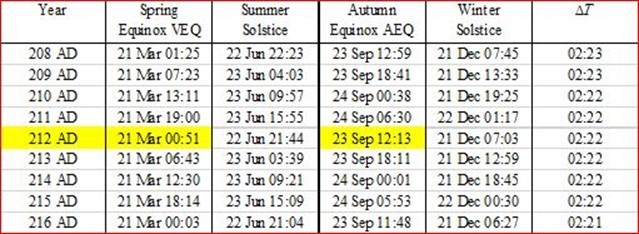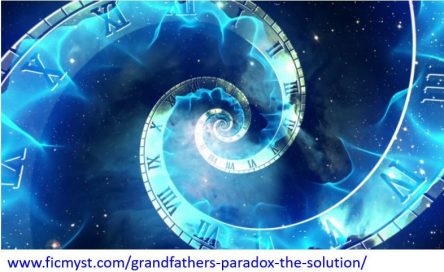
The building complex of HAAP, Horologium Augusti and Ara Pacis Augustae was oriented, designed, and built according to the architectural “light principle and astronomical considerations” of the great Roman architect Marcus Vitruvius Pollio, furthermore based on the astronomical calculations of the famous mathematician Facondus Novius.
Because of the established connection between HAAP and AEQ, it is essential to point out again that VEQ and AEQ move perfectly together in the sky. They also keep together in the calendar if we calculate the hours and minutes.
Beginning from BC9, the VEQ has shifted from 23 March to 22 March in 2 of every 4 years. Along with this, between 9BC and AD11, the AEQ day fell on 25 September every year. Of course, this was only the case if the leap years followed each other correctly for 36 years after BC45, i.e., every 4 years without a 3-year leap year error, as we have shown earlier.

Table 9. Source
Adding 220 years to BC9 (-8), we arrive at AD212 = 212CE, which is the new first year of the HAAP’s operation, as we assume. Around 212CE, VEQ fell on 21 March. The VEQ day on 21 March typically coincides with an AEQ day on 23 or 24 September, as we have already seen.
Let’s have a look at what our VEQ/AEQ table around 212CE says:

Table 10. Source
Tables 9 and 10. show the UT time values. The Roman zone time is 1 hour more, and the local mean solar time (LMST) is only 49 minutes later. On 23 September AD212, the LMST is 13:02 instead of 12:13, depending on the actual value of Delta T. (LMST, Delta T: see Abbreviations.) Shortly after the local noon, it is an almost ideal time to create an average shadow length of a gnomon on an AEQ day.
In analysing the calendar restoration of Emperor Augustus, we have seen that (because of the omission of 3 leap years after 9BC), the AEQ day in the calendar would have changed rapidly between 22 and 25 September. It is easy to see that a similar calendar-date-changing effect would have been produced by a possible calendar reset 220 years later, too.
It is a well-known historical fact that in ancient architecture, buildings were very often constructed that were in some way connected to the vernal equinox (VEQ) and the autumnal equinox (AEQ). The astronomical time of the AEQ played a particularly important role in calendar-making and architecture in the areas of Asia Minor and Egypt conquered by Rome, and it also had a significant influence on Roman attitudes.
Taking all the above together, I think it is likely that the HAAP as a significant calendar instrument was built to function accurately for many years from an astronomical point of view. At the same time, the HAAP construction took advantage of the fact that the birthday of Emperor Augustus happened to coincide with the day of the AEQ. Therefore, I maintain that the HAAP building complex was designed for the astronomical day of AEQ, but not for the calendrical AEQ day, which was to change rapidly, if Emperor Augustus really restored the calendar, whether after 9BC or 212CE.
As seen from the Earth, the sky position of the AEQ point measured to the Sun is stable. This results in given Sun lights directions on the astronomical AEQ days of every year. The required obelisk shadow angle of incidence to Ara Pacis occurs on the astronomical AEQ day of each year. Even the corresponding shadow length produced on the astronomical AEQ day of each year shows only a slight length difference. Even the time of occurrence of a given shadow direction changes year by year only with some minutes. The variation in the shadow length associated with the required direction on the AEQ day falls within a narrow interval in different years, only somewhat more than plus-minus 1,35 meters in the case of the Obelisk of Augustus. If the Horologium were still standing today like erected in BC9, the shadow length of the obelisk would fall within this narrow band even on the present astronomical AEQ day. This is a fact I have verified by Stellarium calculations not detailed here. I am also convinced that ancient astronomers were informed about these simple astronomical facts,
Sunshine design versus shadow design:
Returning back to Buchner’s theory: The earlier mentioned simulation of Professor Frischer et al. refutes Buchner’s “birthday shadow theory”. Despite the fact of this refutation is likely that Emperor Augustus was setting a symbolic monument for himself by building the Ara Pacis and erecting the obelisk.
In my view, Buchner’s theory is not only erroneous about the date of coincidence of the AEQ day and the birthday of Emperor Augustus in 9BC! Buchner’s claim that Emperor Augustus would have chosen the shadow in any building as a positive, celebratory symbol is also a misconception. The shadow was always and is also nowadays a negative symbol.
The emperor had to “cast the main role” on the Sun and sunlight! The Sun was the symbol of Emperor Augustus. As highlighted earlier, he dedicated his obelisk to SOL, the Roman God of the Sun. Emperor Augustus was known for his vanity. Therefore, only a building complex that was linked to the AEQ day as his birthday and at the same time to the Sun could have importance and symbolic meaning for Emperor Augustus.
It is reasonable to state that the birthday function did not operate by the shadow but had to show a phenomenon related to the Sun and sunlight. Furthermore, this supposed “sunlight-related birthday function” worked not in 9BC but functioned 220 years later in 212CE.
The question for me was what the observers staying in front of the Ara Pacis might have seen on the astronomical AEQ day when the shadow of the obelisk moved near Ara Pacis.
This question will be answered in the next post.
